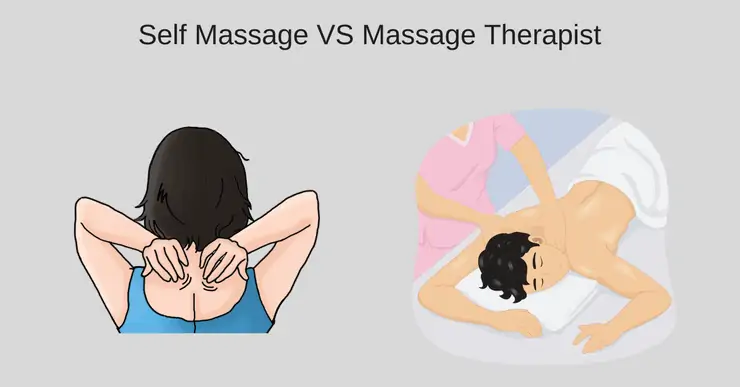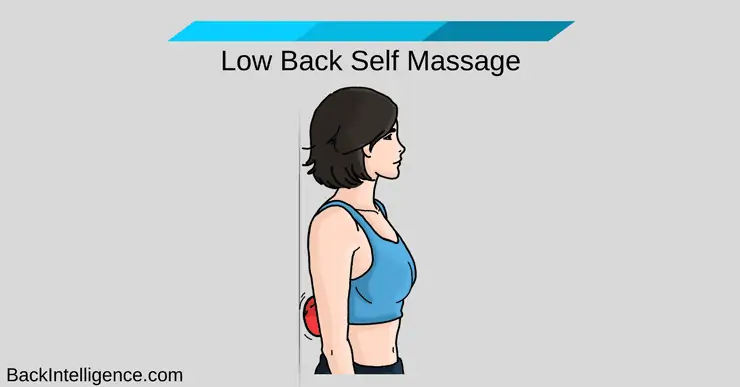
According to the American Massage Therapy Association, approximately 19-28% of adults in the United States had at least one massage between July 2015 and July 2016.[1]
While taking time out of your busy schedule to book a massage with a massage therapist may be nice, sometimes it just doesn’t fit in with the busyness of life (or wallet!). Rather than suffering in pain, you can try using self massage techniques to give yourself an effective massage from the comfort of your home or office.
What are Self Massage Techniques?
Self massage techniques are techniques that you can do yourself to get rid of muscle tightness and trigger points throughout your body.
Many self massage techniques can be performed with your fingers, hands, and elbows, while others require simple items such as tennis balls, foam rollers, or trigger point tools such as the Theracane.
Why Self Massage?
Many people want a self-care option for the relief of pain that is caused by stress, pain and muscle tension.
Especially, if you are someone who is suffering from myofascial pain dysfunction syndrome (MPDS), which is caused by the presence of chronic trigger points – You may need to self massage regularly. Trigger points are tight knots in the muscle tissues that can cause pain, as well as, refer pain to other areas in the body.
According to a 2015 study published in the Journal of Physical Therapy Science, patients suffering with myofascial pain dysfunction syndrome (MPDS) that received self-massage treatment, combined with home exercise, had reduced their pain intensity MORE during their daily activities when compared to individuals that only received six sessions of traditional physical therapy modalities (heat and transcutaneous electric nerve stimulation TENS). [4]
Self Massage Benefits Include:
Benefits of Self Massage over a Massage Therapist
There are numerous benefits of learning self massage techniques, instead of seeking out professional care, including:
- It’s less expensive than paying a professional.
- It’s less time consuming than booking an appointment with a professional.
- You can focus on areas that are really bothering you and apply increased pressure when you find especially tender areas.
- Results are typically rapid when you focus on your problem areas.
- You can do self massage techniques pretty much anywhere including your home, office, or even your car.
- There’s no need to feel self conscious about being touched by someone you don’t know or going into an unfamiliar place, such as a spa or clinic.
Learn More
6 Things to keep in mind when using self-massage techniques:
1. You only need to massage for a few moments for mild cases; or a minute or two for more severe cases.
2. Massage the area at least twice per day.
3. Explore the muscles in the area where you feel pain until you find the specific spot that is especially painful.
4. Apply pressure that is strong, but tolerable (tip: start with light pressure and work your way up).
5. If you experience pain afterwards ease up the next time you apply self treatment.
6. Gently stretch out the area after self massage treatment.
9 Best Self Massage Techniques (For Diff Parts of Body)
1. For Head Self Massage
Nothing can ruin a perfect day like a throbbing headache. Try this simple self massage technique to relieve your head pan.

What you’ll need – Your Hands
How to do it:
- Place your thumbs high on your cheekbones, by your ears.
- Gently apply pressure in a circular motion with your fingertips to your temples.
- Continue making circles as your move along your hairline, until your fingertips meet in the middle of your forehead.
2. For Neck Self Massage
Sitting at a computer all day can make your neck stiff and sore, doing this simple self massage technique will help to relieve tension and ease your pain.
What you’ll need – Your Hands
How to do it:
- Place two or three fingertips on the back of your neck where your neck meets your shoulders.
- Apply firm pressure and hold the area.
- Release when the muscle feels more relaxed.
- Roll your shoulders forwards and back slowly.
- Repeat three times.
3. For Shoulder Self Massage
Poor posture and hunching at a desk all day can lead to rounded shoulders and shoulder pain. Doing this simple self massage technique can help to alleviate your pain.
What you’ll need – Your Hands
How to do it:
- position the fingers of your right hand over your right shoulder (your upper trapezius will be underneath your palm).
- squeeze your upper trapezius three times and then roll your fingers over the muscle starting from the outside and moving towards the base of your neck.
- repeat on your left side.
The Complete Posture Fix (With Dr. Oliver) – Fix your fwd head and rounded shoulders posture, ergonomics, get out of pain and increase your mobility.
Learn More
4. For Lower Back Self Massage
Lower back pain is a very common complaint and can be disabling in some cases. Unfortunately, everyday activities such as cleaning and gardening can make your lower back pain even worse. You can alleviate your lower back pain by doing this quick technique.
What you’ll need – A massage ball/tennis ball and wall
How to do it:
- Position a massage ball/tennis ball between your lower back and a wall.
- Move your body up and down, or side to side to find areas of tension.
- Apply a stronger pressure in the tender spots to help release the tension.
5. For Chest/Pecs Self Massage
If you have rounded shoulders from sitting at a computer all day or from poor posture, you likely have trigger points in your pectoralis muscles. Learn how to use the Theracane to release these trigger points, which will help to relieve pain and correct your shoulder positioning.
What you’ll need – Theracane or another trigger point manual massager
How to do it:
- grab the hook of the Theracane and position the knob in the grove just below your collarbone.
- apply downward pressure on hook to help release the trigger point.
- move the hook to apply the pressure at different angles to work the whole muscle.
- perform on both sides.
6. For IT Band & Leg Self Massage
If you tend to move around a lot, you probably have a lot of tightness in your iliotibial (IT) band, which is the band of tissue that runs from your hip to just past your knee. Try this simple exercise for leg pain relief.
What you’ll need – Foam Roller
How to do it:
- begin by lying on your side with a foam roller positioned under your hip.
- use your hands to brace yourself as you slowly roll down from your hip to your knee while rotating your body towards the ground as you move down.
- slowly roll back to the starting position.
- perform on both sides.
7. For Foot Self Massage
Running, jogging and prolonged walking can be torturous for your feet. By the end of the day, your feet may be aching so badly that you want to scream. The goods news is that your foot pain can be relieved with this simple exercise.
What you’ll need – Massage Ball Or Tennis Ball
How to do it:
- sit in a comfortable chair with your feet bare or with a sock on.
- position the tennis ball under your foot.
- roll back and forth from heel to toe using firm pressure.
- if you come across a painful or tender area, work the knot out by rolling in small circles.
- do this exercise on both of your feet.
- to add more pressure, try performing this technique while standing.
8. For Buttocks/Hip Self Massage
Trigger points in your gluteal muscles can be uncomfortable, try this simple technique for pain relief.
What you’ll need – Massage Ball Or Tennis Ball
How to do it:
- begin in a seated position on the ground with your knees bent.
- position a tennis ball under your right buttock and rest your hands on the ground behind your back.
- lift your right leg off the ground and roll in small circles on the ball, placing more attention on areas that are tender.
- perform this exercise on the left.
9. For Hand Self Massage
Whether you sit at a computer typing all day or do a job that involves using your hands repetitively, your hands may be aching at the end of the day. Learning how to self massage your hands can help to relieve tension.
What you’ll need – Your Hands
How to do it:
- begin by placing your fingers over your wrist, as if you’re taking your pulse, and apply a side to side pressure across your wrist.
- move to the heel of your palms and start applying pressure in a small circular motion, working your way from the pinky finger side and moving towards your thumb side.
- next, grasp the web of tissue that connects your thumb to the rest of your fingers and gently move it up and down.
- then apply pressure by using a small circular motion to the muscles at the base of your fingers.
- next move up each finger using small circular strokes.
- once you reach your finger tip, gently pull the finger to stretch the joint.
- perform on both sides.
The Complete Posture Fix (With Dr. Oliver)
Fix your fwd head and rounded shoulders posture, get out of pain and increase your mobility.
Learn More
In conclusion, muscle tension and trigger points can cause a lot of pain and discomfort and making time to see a massage therapist might not be possible. There’s no need to worry if you can’t make time to see a professional, or if you’re uncomfortable in a spa setting because you don’t like the idea of someone you don’t know touching you, learning the simple self massage techniques above will help to ease your pain and get you back to doing your normal activities soon.
Related:
What are trigger points
How Poor posture causes back pain
Best Herniated Disc Stretches
Cat and Cow Stretch for low back pain relief
Forward head posture exercises
Back pain between shoulder blades
Back Intelligence Homepage
Rounded shoulders exercises
[1] American Massage Therapy Association. Massage Therapy Industry Fact Sheet. Published 2018. Accessed November 14, 2019.
[2] Mense S. Differences between myofascial trigger points and tender points. Schmerz. 2011 Feb;25(1):93-103. doi:10.1007/s00482-010-0965-4
[3] Borg-Stein J, Stein J. Trigger points and tender points: one and the same? Does injection treatment help? Rheum Dis Clin North Am. 1996 May;22(2):305-22. doi:10.1016/s0889-857x(05)70274-x.
Licensed chiropractor, DC (Owner of Forme Clinic, Stoney Creek, ON, L8G 1B9)
Dr. Shaina McQuilkie graduated from Brock University in 2004 with a Bachelor of Kinesiology (Honours). She then attended D’Youville College, in Buffalo, New York and obtained her Doctorate of Chiropractic Degree in 2008. After graduating, Dr. McQuilkie practiced in a multi-disciplinary healthcare facility based in Hamilton, Ontario gaining experience treating a variety of musculoskeletal injuries.











